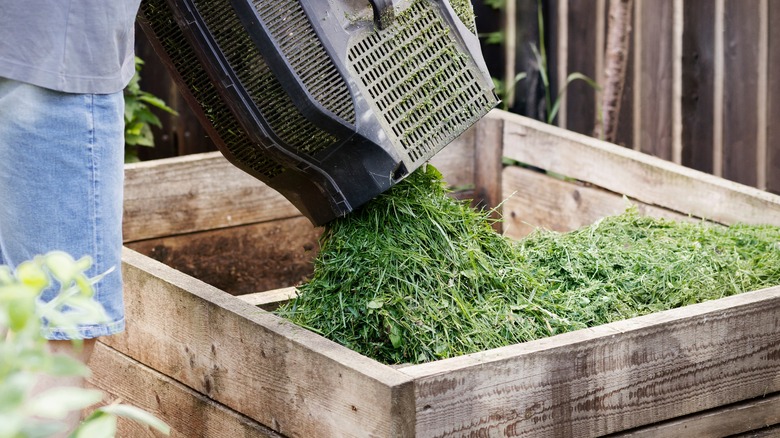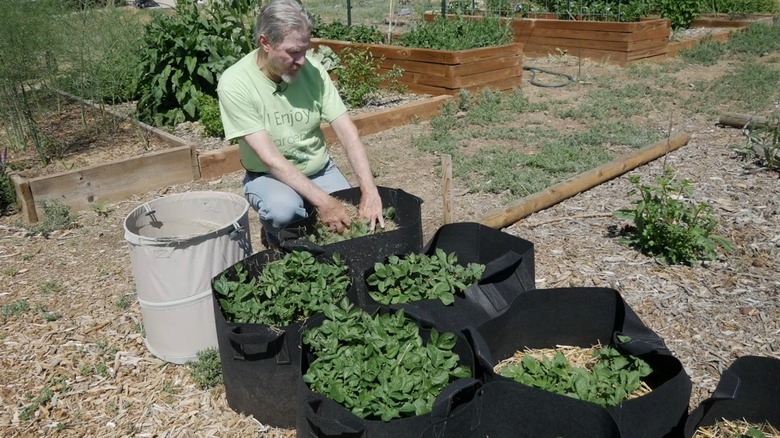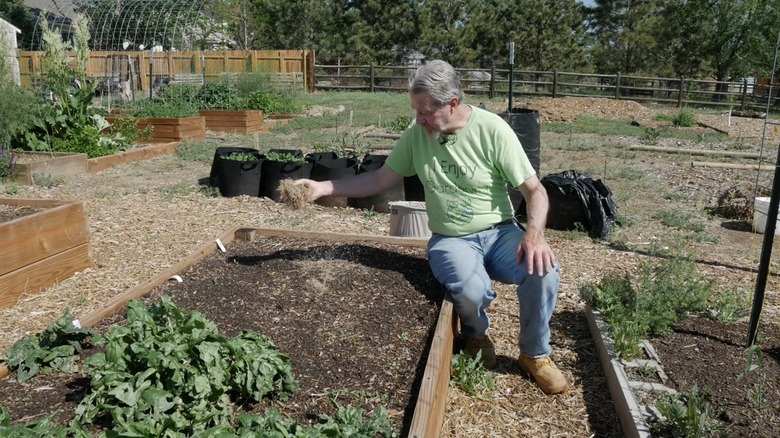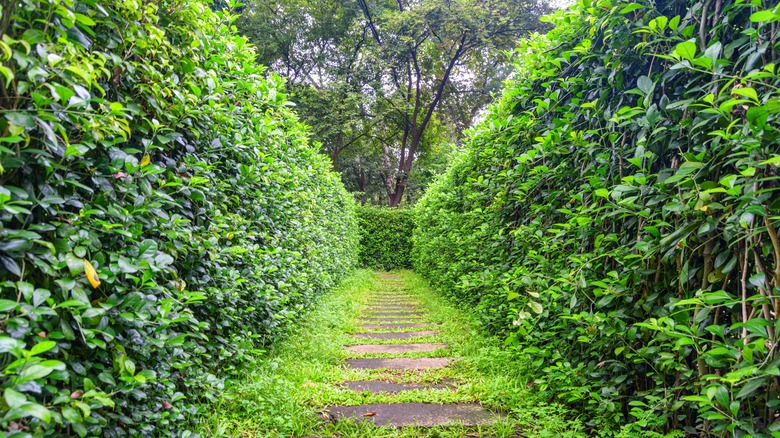12 Ways To Repurpose Your Lawn Clippings For A Healthier Yard And Garden
It's the weekend; you've spent hours trimming the overgrown grass to restore its lush, manicured look and have gained a bagful of lawn clippings in return. Now what? Should you bag them up and just send them off the landfill (assuming your state still allows it)? That would be a waste of such a useful resource. Lawn clippings are chock-full of nutrients and organic matter; reusing them in your yard will improve it. The University of Missouri mentions how returning grass trimmings to the yard not only reduces its fertilization requirements by 25% but also coaxes soil-based microbes into picking the slack. It works a similar magic in garden beds while suppressing weeds when used as mulch. The lawn trimmings can also be steeped to make fertilizer tea, in addition to scores of other reuses, as we outline below.
Repurposing your lawn clippings also does a world of good to the environment — on two counts at that — according to the University of Minnesota. It reduces the energy expended on treating lawn waste by 3% and improves carbon sequestration, sometimes by as much as 59%. However, there are certain caveats. The lawn must be mowed with sharp blades when it's dry, or else the clippings will mat out, spewing trouble in place of benefits. Also, you should avoid using grass offcuts from a diseased lawn, lest they spread the disease elsewhere in the yard, although they can be composted.
1. Leave the clippings on the lawn
Unless your neighborhood/HOA has policies for bagging clippings to ensure a uniform turf look, leaving the trimmings on your lawn — aka grasscycling — is the best option. This will improve the soil's texture, nutrient profile, and drainage, resulting in massive fertilization and irrigation savings. However, ensure they measure no longer than 1 inch, as longer clips take longer to decompose, suppressing the new growth in the meantime. While mulching mowers are preferable, they aren't mandatory, and side-discharge mowers can be used, with homeowners noticing significant green-up effects in one season, albeit with delayed impact.
2. Use lawn clippings as an organic fertilizer
Fresh grass clippings (FGC) are often treated as soil conditioners, especially when improving the texture of clay or sandy soils is paramount. For this to work, a 3-inch thick layer of lawn trimmings should be incorporated into the soil down to 12 inches. As the microbes work their magic and decompose the grass, they release heaps of macronutrients, such as nitrogen and organic content, enriching the loam. However, avoid using clippings from a lawn that has already gone to seed, or you'll be left floundering for ways to kill grass in flower beds.
3. Mulch garden beds with lawn trimmings
Rather than working dry clippings into the soil, lay them 1 inch thick around the plants. The layer behaves as mulch, subduing weeds, improving water retention, and maintaining adequate soil temperatures. On a slope, it may even stave off leaching. To avoid the awful smell that accompanies decaying grasses, wait for the top layer to dry down completely before adding more to create a 4- to 6-inch mulch layer. That way, the trimmings won't interfere with the soil's airflow. Skip this if your lawn was treated with herbicide or weed killers the previous fortnight.
4. Add grass clippings to the compost bin
When your grass clippings are too long, have been chemically treated, or are available in excess, consider adding them to the compost bin as "green material" and for moisture. However, at no time should their proportion exceed 50% of the bin's volume, which also holds browns, like wood chips, sawdust, and leaf shed. That's because the grasses hasten the breakdown, consuming oxygen while simultaneously blocking new air movement and causing the compost to stink to the high heavens. Turn over the compost every two days in the summer and weekly in the fall.
5. Build a lasagna garden
No-dig, cost-conscious gardeners can jump-start their fall garden beds with grass clippings by going the lasagna planting way. Simply alternate the browns, such as twigs, dried leaves, newspapers, pine needles, and corn cobs, with greens — lawn clippings in this case, although kitchen waste and coffee grounds can be sprinkled in as well — in a 2:1 ratio, starting and ending with the browns. Your rich soil will be prime for spring planting and will certainly be appreciated by the Solanaceae family (tomatoes and peppers). Root and leafy veggies, including spinach and lettuce, can also be planted.
6. Steep lawn clippings for fertilizer tea
Sometimes, yard owners may end up with a deluge of trimmings, which can't be consumed fully as mulch or amendment. In such cases, an effective solution is to make grass-clipping "tea" to nourish your plants. Stack (and lightly compress) the blades until the bucket is half full, and fill the rest with (preferably) rainwater. Cover the bucket and let the drenched blades stand for around two weeks. Filter the concentrate and dilute it in water in a 1:10 ratio before watering your plants with it. Then, add the decayed clippings to the compost pile.
7. Incorporate grass trimmings in potted plants
Lawn clippings can benefit your potted plants, grow bags, and containers immensely, particularly when laid down thick as mulch. For instance, many container gardeners who prefer growing potatoes with the no-dig method resort to plowing their tubers and topping them up with grassy blades to help moisture retention, sometimes entirely doing away with the need for watering. The trimmings are reapplied every two weeks or so until harvest, although weed seeds can be a concern. Besides, the decaying grasses return nutrients to the potting mix, improving plant vigor and health.
8. Use the grassy clips as animal feed
A Colorado State Extension study concluded that grass clippings — both fresh or turned into silage — are an inexpensive way to feed sheep. In fact, homestead owners can similarly reward their goats, cattle, or rabbits with newly cut trimmings, provided they're fully dry. Chickens, too, relish juicy lawn snips, though you must ration the amount to a few handfuls and ensure it hasn't been chemically treated or fertilized recently. However, horses are an exception to this rule; the fermenting grasses may induce gas build-up in their system, inviting diseases like colic and diarrhea.
9. Turn lawn clippings into bedding
Gardeners who dabble in chicken rearing as a hobby can add lawn trimmings as another bedding option to their already big arsenal, which runs the gamut of straw, sand, wood shavings, rice hulls, and cardboard. This will also keep them busy screening the snips for any bugs that may have outsmarted the mower. The baseline requirement is that the cut grasses should be dried out in the sun before using. Otherwise, they'll mat together and turn into breeding homes for mold. Naturally, this won't bode well for your baby chicks, impairing their respiratory systems.
10. Protect seedlings with snipped grasses
Newly sown seeds and delicate juvenile plants can die prematurely if the dirt becomes too hot or if they aren't watered adequately, leaving their roots parched and weak. However, scattering a very thin layer of lawn clippings on the ground can stave off this danger to an extent. The condition is that the fresh cuttings have been given sufficient time to dry down completely so they're feather-light and not weighing down the seedlings. After you're done giving your plants their timely soak, the grass will eventually blend into the soil, improving the nutrient profile.
11. Sprinkle lawn clippings around the hedges
There's another lawn clipping trick that numerous gardeners use to defend their garden hedges against a weedy intrusion. It involves dusting the area underneath shrubbery with a 1 ½-inch thick layer of verdant blades early in the season so that scrawny growth gets no chance to rear its ugly head. Don't go overboard, as fresh clippings absorb the soil's nitrogen and can block water movement in the initial stages while decomposing. They must also have no contact with the main stem. Remember, regularly topping up the clipping mulch is essential to maintain effective control.
12. Share or donate the lawn clippings
In case you lack the time, commitment, or a garden to repurpose your lawn clippings, you can collect, bag, and share them with gardening neighbors, friends, or family. No-lawn enthusiasts can specially make use of the trimmings as garden mulch. Another alternative is to hand the bags over to the local community garden or schools, provided they aren't carrying grass seeds or chemical residue. If nothing else materializes, you might want to look into the local recycling centers — avoid trashing or burning the clippings.












